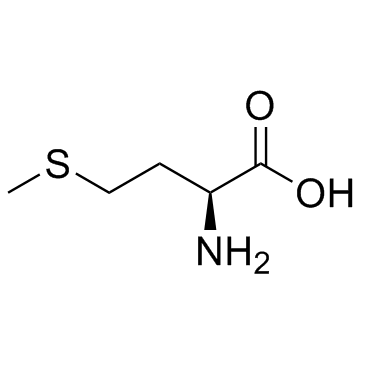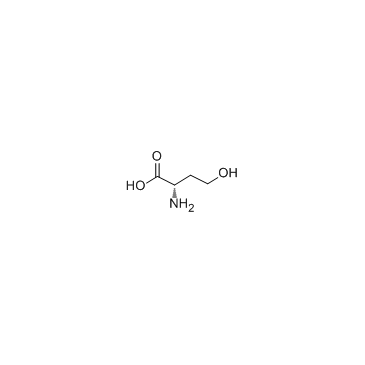1115-84-0
| Name | L-Methionine-S-methyl Sulfonium Chloride |
|---|---|
| Synonyms |
dl-methionine methylsulfonium chloride
d,l-(3-amino-3-carboxypropyl)dimethyl sulfonium chloride l-methionine s-methylsulfonium chloride methylmethioninesulfonium chloride dl-(3-amino-3-carboxypropyl) dimethylsulfonium chloride EINECS 200-625-0 dl-methylmethioninesulfonium chloride methiosulfonium chloride MFCD00031700 methylmethionine sulfonium chloride |
| Description | Vitamin U (S-Methylmethionine sulfonium) chloride is an orally active anti-ulcer agent with antioxidant activity. Vitamin U inhibits adipocyte differentiation. Vitamin U promotes skin wound healing.Vitamin U can be used in the research of gastrointestinal ulceration[1][2][3][4][5]. |
|---|---|
| Related Catalog | |
| In Vitro | Vitamin U chloride (100 μM, 24 h) promotes the growth and migration of human dermal fibroblasts(hDFs)[1]. Vitamin U chloride (0-1 mM, 24 h) activates ERK1/2 in hDFs[1]. Vitamin U chloride (0.1 g/L in the nutrient solution) reduces cell membrane damage in higher plants exposed to low-temperature stress[2]. Vitamin U chloride (10-100 mM, 7 days) inhibits adipocyte differentiation via down-regulation of adipogenic factors and up-regulation of AMPK activity[3]. Cell Proliferation Assay[1] Cell Line: Human dermal fibroblasts(hDFs) Concentration: 100 μM Incubation Time: 24 h Result: Promoted hDFs proliferation. Western Blot Analysis[3] Cell Line: 3T3-L1 cells Concentration: 50, 70, 90 mM Incubation Time: 7 days Result: Increased AMPK phosphorylation and decreased PPAR-γ levels. |
| In Vivo | Vitamin U chloride (50 mg/kg, oral gavage) prevents valproic acid-induced liver injury in rats[4]. Vitamin U chloride (50 mg/kg, oral gavage for 3 days) shows antioxidant effect and prevents GalN-induced gastric damage in rats[5]. Animal Model: Valproic acid (VPA)-induced rats with liver damage[4] Dosage: 50 mg/kg Administration: Oral gavage Result: Blocked the decrease in catalase (CAT), glutathione reductase (GR), glutathione peroxidase (GPx), and superoxide dismutase (SOD) activities. Increased in the levels of IL-1β, active caspase-3, and cytoplasmic cytochrome c. Increased in the number of proliferating cells nuclear antigen (PCNA) positive hepatocytes. |
| References |
| Melting Point | 134ºC |
|---|---|
| Molecular Formula | C6H14ClNO2S |
| Molecular Weight | 199.69900 |
| Exact Mass | 199.04300 |
| PSA | 88.62000 |
| LogP | 1.16860 |
CHEMICAL IDENTIFICATION
HEALTH HAZARD DATAACUTE TOXICITY DATA
|
| Hazard Codes | Xn,N,T,F |
|---|---|
| Risk Phrases | R10:Flammable. R20:Harmful by inhalation. R51/53:Toxic to aquatic organisms, may cause long-term adverse effects in the aquatic environment . R40:Limited evidence of a carcinogenic effect. R39/23/24/25:Toxic: danger of very serious irreversible effects thr |
| Safety Phrases | S24/25-S61-S36/37-S45 |
| RIDADR | UN 1134 3/PG 3 |
| WGK Germany | 2 |
| RTECS | CZ0175000 |
| Packaging Group | III |
| Hazard Class | 3 |
| HS Code | 2930909090 |
|
~72% 
1115-84-0 |
| Literature: Mladkova, Jana; Vanek, Vaclav; Budesinsky, Milos; Elbert, Tomas; Demianova, Zuzana; Garrow, Timothy A.; Jiracek, Jiri Journal of Medicinal Chemistry, 2012 , vol. 55, # 15 p. 6822 - 6831 |
| HS Code | 2930909090 |
|---|---|
| Summary | 2930909090. other organo-sulphur compounds. VAT:17.0%. Tax rebate rate:13.0%. . MFN tariff:6.5%. General tariff:30.0% |



